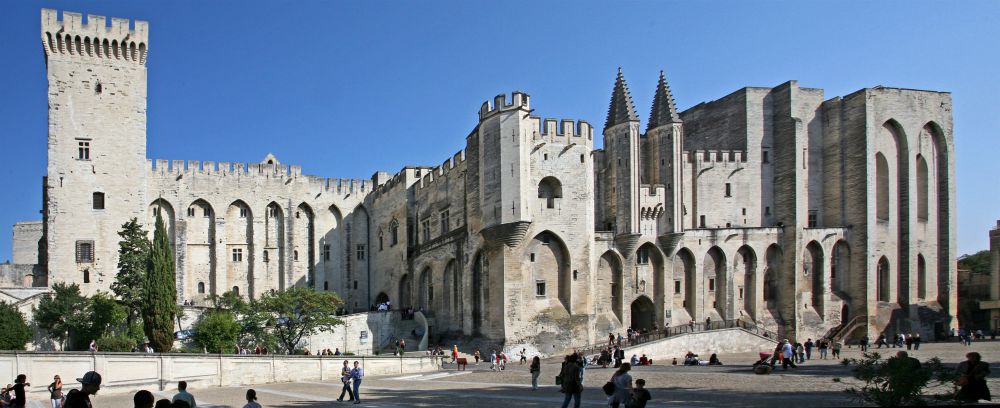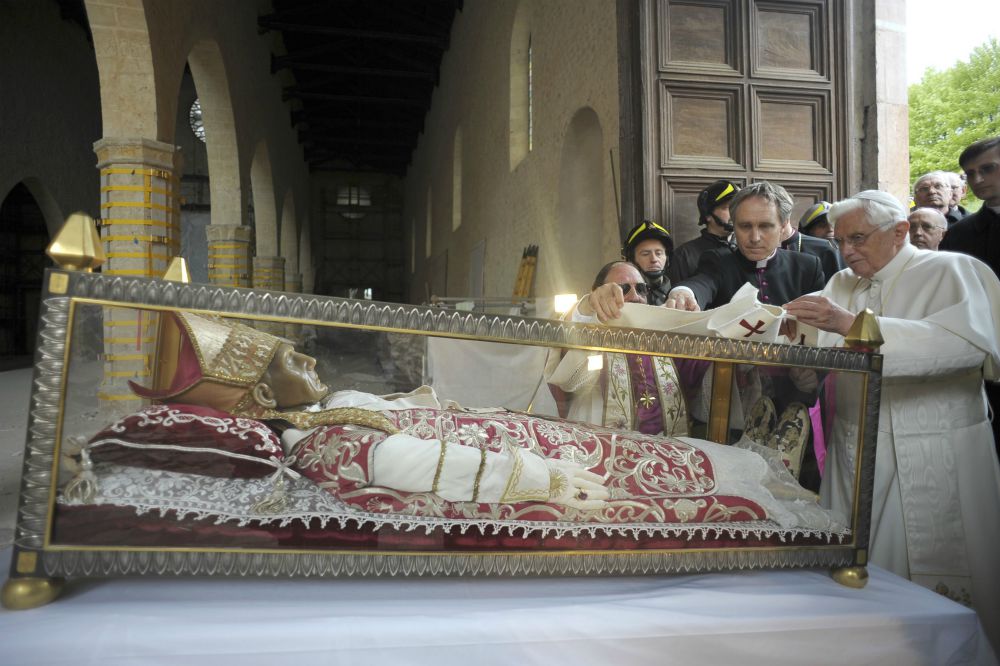
"Palais des Papes," the papal palace at Avignon, France, pictured in 2008 (Wikimedia Commons/Jean-Marc Rosier)
The second episode of CNN's series "Pope: The Most Powerful Man in History" aired last night. It started with a more narrow focus than the first episode, looking at the resignation of Pope Benedict XVI. But, in fact, it looked at previous papal resignations and did so in a way that was more intelligent and instructive than I had anticipated.
The first few minutes were inauspicious. We were invited to remember that February day when news broke that Benedict XVI was resigning, and how much fun it was to watch television news anchors stumble over names and dates from 700 years back. But, the initial commentaries were weak or foolish.
The University of Pennsylvania's Anthea Butler observed: "The problem with having two popes is you have to decide who you listen to." No, you don't. Such an observation might have made sense five years ago, as a concern, although anyone who knew anything about Pope Benedict's sense of history would know he would be attuned to the danger. Five years on, is anyone in any doubt about "who you listen to?" Academics should not help producers introduce intrigue where there is none.
Similarly, historian Diarmaid MacCulloch started out strong — "It's left us with this situation of a pope and an extra pope, and that's always going to change the nature of an institution" — but why did he feel the need to add, "Who is the real pope?" Indeed, one of the remarkable facts about the opposition to Pope Francis is that it has not once manifested itself in the form of claims that Benedict's resignation was somehow illicit. There are people who claim the see of Peter is vacant and point to intrigue surrounding conclaves in 1978 and 1958, but no one asks, "Who is the real pope?"
The lack of drama in the past five years became evident as the show looked back to Pope Benedict IX in 1032, and historian Eamon Duffy observes, "In the 10th and 11th centuries, if you've got two popes, you've got two factions." Thus began a remarkably astute look at how the papacy became intermingled with politics in ways that robbed the institution of its spiritual core.
Advertisement
Benedict IX, of course, was a special case. He was probably still a teenager at the time his powerful family secured his election as pope, and his incompetence vied with his moral corruption for significance. After a dozen years of his disastrous rule, the cardinals convinced him to sell the papacy, and he resigned for a cash payment. His successor, Sylvester III, was only on the papal throne a few months when Benedict returned with an army to reclaim the papacy. Sylvester fled. Again, Benedict tired of the job and assigned it to his godfather, who became Gregory VI. You can guess the next chapter in the saga, yes? Benedict again changed his mind and attempted to reclaim the papal throne. There were now three popes!
This scandal led to one positive outcome. Papal elections were irregular. Sometimes the people played the key role, other times backroom intrigues presented the new pontiff to the people as a fait accompli. Roman families and foreign potentates competed for influence. Finally, after the disaster of the three popes, the cardinals reserved to themselves the right to elect a pope, and they instituted the conclave, the idea that they would lock themselves inside the papal palace while they voted so as to eliminate outside interference. They were not entirely successful, but since the 11th century, their right to serve as sole electors has been unquestioned.
The resignation of Celestine V was catapulted into the modern imagination after the 2009 earthquake in Aquila, Italy, where he was buried at the basilica of Santa Maria di Collemaggio. Pope Benedict XVI visited his remains while inspecting the earthquake damage and he placed the pallium he had worn at his installation on Celestine's tomb. In retrospect, he was giving us a not so subtle sign that he was at least aware of the precedent.

Pope Benedict XVI places a white stole on the remains of St. Celestine V, a 13th-century pope, during his 2009 visit to the earthquake-damaged Basilica of Santa Maria di Collemaggio in L'Aquila, Italy. St. Celestine was the last pope to voluntarily resign before Pope Benedict stepped down in February 2013. (CNS/Reuters/L'Osservatore Romano)
In discussing Celestine's election, brief reign, and the politics that surrounded his resignation, the CNN producers do a truly fine job explaining how and why the papacy was kidnapped by King Philip IV and brought to Avignon. The show even does a good job at what we might call B-roll facts, information not actually about the papacy but necessary to understanding the context. For example, the narrator observes that during the time in question, Italy was subject to intense foreign intrigues with the Normans setting up control in the south of the peninsula, the Germans in the Northwest and the French in the Northeast. For those of us who swim in the waters of history and church history, the late emergence of a unified Italy — and a unified Germany — are among the most dominant facts of geopolitical history for centuries. CNN has viewers who might not even know that these two great countries did not achieve political unity until the late 19th century, and unless you understand that Italy was not politically united, much of the history of the papacy is incomprehensible.
The show's treatment of the Western Schism is similarly well done. The interplay of politics and personality in fashioning the historical record is made clear, and there is no whitewashing of some of the uglier episodes in ecclesiastical history. My great mentor Msgr. John Tracy Ellis used to bemoan what he called "wine and roses" that presented the history of the church as if it was a series of endless triumphs. "Gentlemen, and sister [we had one nun in our class]," Monsignor began the semester, "in this classroom you will learn that as often as not, the Bride of Christ has a few warts." The CNN series shows the warts, but in context. There is no "whore of Babylon" narrative. It is all very human, and it shows the degree to which the concern to maintain power has been at the heart of almost all of the church's troubles through the centuries.
Finally, the show returns to the resignation of Pope Benedict XVI. Again, Professor Butler offers an observation that left me scratching my head. She said of his decision to resign "that's thinking more like a CEO than anything else." Why a CEO? All sorts of people resign from office because they feel physically unequal to the job. Strange.
It falls to Professor Duffy to make the important observation. "In a way, the act of resignation was a devastating comment on the last five or six years of his predecessor," Duffy rightly comments. "A flight in the face of the whole theology of the papacy as it had evolved in modern times, the notion that John Paul had perhaps propagated that the papacy was a cross which was laid on your shoulders and you could not shake it off. Benedict said, 'Well, it's a job, and if you can't do it, you should let somebody else try.' "
Bishop Paul Tighe of the Pontifical Council for Culture adds that the resignation was "a reminder to everybody in any position of authority or power that 'it's not just about me,' it's about — 'am I actually being effective? Am I really serving the community and the church properly?' "
Those who complain about the hierarchy, and especially those who complain about the lack of power sharing in the church, need to watch this episode of the CNN series. Whenever a pope or cardinal or king has aspired to power over the church, he has undercut the spiritual foundations of the papacy and, with those foundations, the mission entrusted to the church by Jesus Christ. Yes, sometimes the language of service masks an intense power struggle, but those who want the church to flourish cannot pretend to have her best interests at heart if they join in the machinations for power.
One last observation: As I noted last week after the first episode, the opening montage jumps from a picture of John XXIII to one of John Paul II. Wither Paul VI? That same montage opened the second episode too, but this time I noticed something that offsets my frustration with their overlooking Paul VI. In the picture of John Paul II, just over his right shoulder is the late, great Archbishop John Quinn!
[Michael Sean Winters covers the nexus of religion and politics for NCR.]
Editor's note: Don't miss out on Michael Sean Winters' latest: Sign up to receive free newsletters, and we'll notify you when he publishes new Distinctly Catholic columns.







